So, the weekend before last I was up in Derbyshire, and thought I’d pay a visit to some of the locations I used (in rather tweaked form) for The Footballer’s Mistress (in A Series of Ordinary Adventures). When I wrote the story, I was mainly visualising Bamford Mill in Derbyshire’s Hope Valley, but the same tales could be told about many of the regions former mills that have been converted to luxury apartment complexes and housing developments. Don’t get me wrong: I love seeing old, abandonded buildings put to new uses, but I always wonder what the buildings and any existing residents (non-human and/or supernatural) might think about the changes.
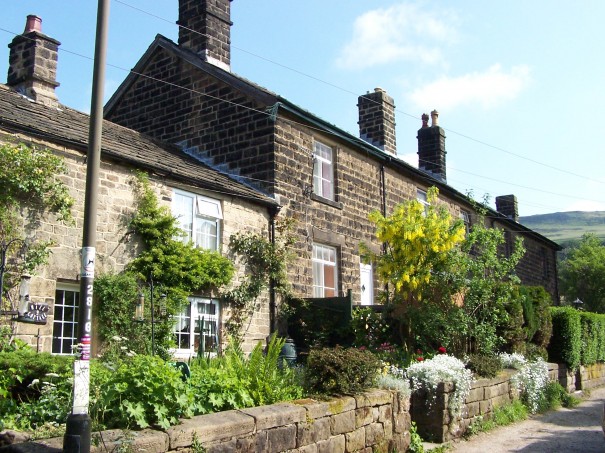
I began my walk by passing down the old millworkers cottages, which line one side of The Hollow in Bamford (we used to be quite simplistic in the names we gave our village roads and paths).The photo on the left shows a view looking back up past the cottages.
Turning to continue our journey to the mill, we see ahead on the left what used to be a rather rough car park, but is now mostly grassed-over, and on the right the small wood where local children used to play. Sadly, the wood is now closed-off and the rope swings that Poppy saw are no more, but here’s the description of how she saw it, based on how I remember it:
The copse stood as it always had, in the space between the mill and the mill workers’ cottages. The iron railings surrounding it had bent and rusted over the years, and the trees had grown taller; now a rope swing hung from the lowest branch of the great horse chestnut and a den, constructed of planks and sacking, nestled amongst the tree’s smaller brethren.
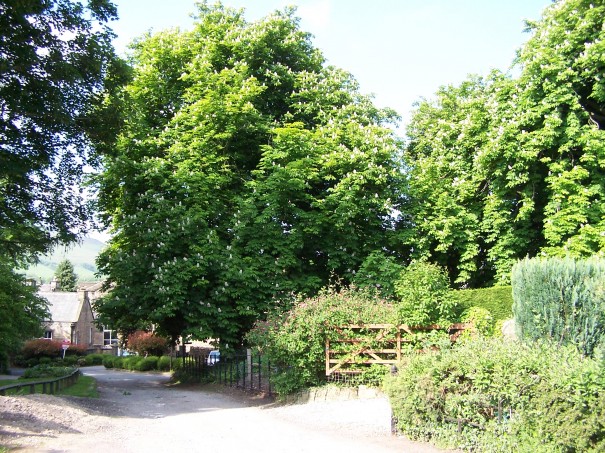
As the sun sank lower in the sky, the copse filled as it always had, with laughter and movement. Children climbed the trees, hid in the den, and swung on the rope. Their clothes—very similar whether worn by boys or girls—were brightly coloured under fresh dirt, and they called out unfamiliar names, but their presence served to reassure Poppy that all was right with the world.
Later, Poppy interacts with the children a little more:
Some of the younger children, those that tagged along with older brothers and sisters, looked straight at Poppy, but when she reached out an encouraging hand to them, they backed or ran away, hiding from her amongst the trees.
The older children couldn’t see her, but she hadn’t expected they would. She came to recognise individuals amongst them, and slowly learned some of their names and their relationships to each other. They came from such small families for the most part; few had more than two brothers or sisters, and almost half of them had none, although there was a raucous gang of red-haired and freckled boys and girls who all seemed to be related to each other in one way or
another.
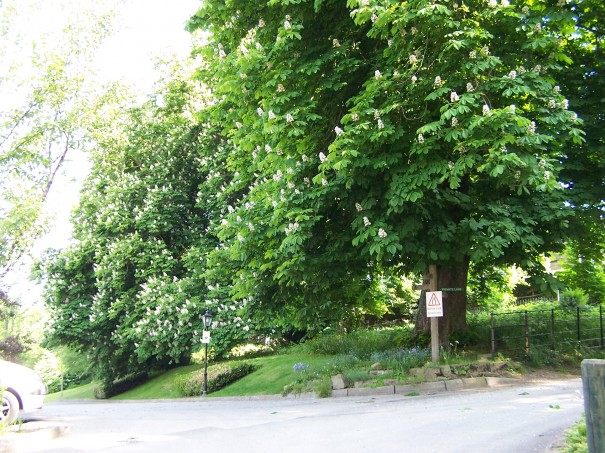
It had surprised her to see so many brown faces amongst the paler ones: one or two of them darker-skinned than she had been in life, with noses like her own; three sisters whose parents must have come from the Indies; others from yet further to the east. All chattered in accents that Poppy recognised as local, not that different in intonation from the way she and her friends had talked, even if many of the words made little sense.
Like the men, the children had little need of Poppy’s protection. The older ones looked out for the younger children, and all had loving parents to go home to. What little infighting took place had resolved by the following day, and the worst injuries that occurred were grazed knees, twisted ankles, and black eyes from the more adventurous games.
Turning right at the corner of the copse takes us down past the new houses (by the definition of new that applies in the UK anyway), and then a left takes us down to the River Derwent, where it runs past the mill.
Here’s Poppy again:
As the men began to pack up their tools into horseless wagons, voices called the children home from their play. Poppy wanted to follow them, to see if the cottages were much changed since she had lived in one, and visited the inhabitants of others.
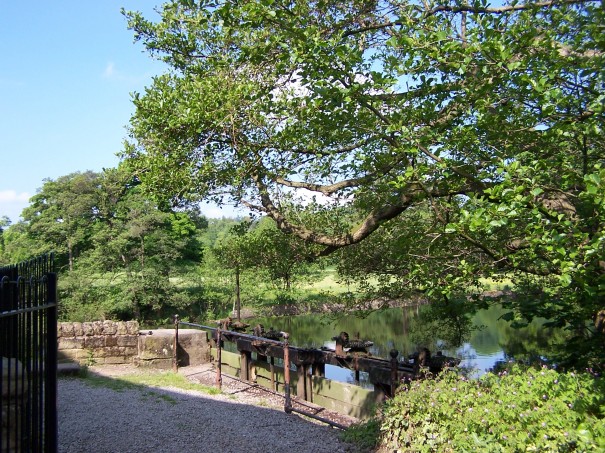
The invisible chain, which for many years, although not always, had kept her within the walls of the mill, brought her to a halt halfway across the track running between the mill and the copse. Disheartened, Poppy turned and drifted down the track until she could go no further, then turned again, and followed the narrow footpath that led to the millrace.
Water rushed beneath the wooden boards of the path, over the weir, between the stepping stones beyond. The great mechanism that once had controlled how much water passed under the mill wheel, and how much continued in the river, was rusted over and encased in moss. Cattle grazed in the fields that other people could reach by passing over the stepping stones; they were black and white rather than the brown cows that Poppy remembered from before. Ducks swam in the mill pond, and a kingfisher dived into the river.
Turning, Poppy saw that the mill’s buildings had decayed still more than its mechanism. The roof was open to the sky in places, windowpanes broken or missing, doors sagging on their hinges. The men would rebuild it. It would gain new life, and Poppy would be needed again. She would watch over new mill workers, protect them from new dangers. Before they came, she would watch over the men who had come to resurrect the place where her life had been extinguished.
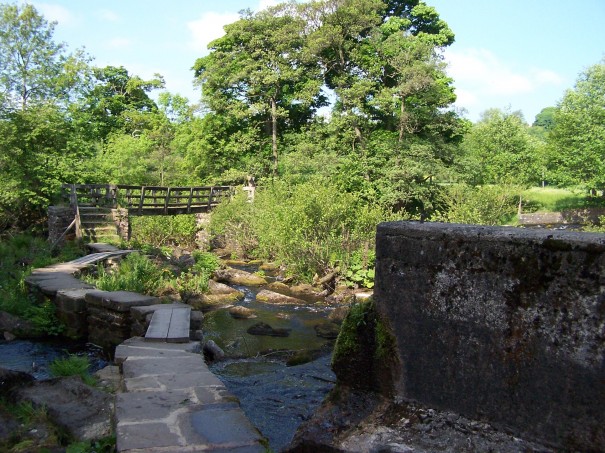
Crossing the river by means of the stepping stones and bridge, we can look out across the fields (no cows on that day) towards the television mast up above Shatton. But first, a little of Poppy’s life within the mill once its new inhabitants start to arrive:
More wagons arrived daily, discharging their contents into the various dwellings, filling up formerly empty space with furniture, people, and merriment. Poppy followed the moving-men, picking up items that fell from boxes, and reuniting lost property with distraught owners. Throughout the comings and goings, there was no sign of the footballer’s mistress, as an intrigued Poppy now thought of the top floor’s other occupant.
She understood football—at least, she thought she did. It was a game that the young men had played after church on Sundays, down on the recreation ground, cheered on by the boys, the older men, and those women who had a fancy for one or other of the players. The lads from the cottages up the lane, and the lads newly moved into the mill, played a rough form of football, too, and sometimes their sisters joined in. Neither of these could be the game played by the footballer whose mistress would soon be arriving.
By slipping into various of the dwellings at night when all the occupants had returned home, Poppy slowly began to understand about this other football. The great glass panels on their walls showed moving stories, like in the travelling picture house, but with sounds accompanying the actions. On these screens, some of the families watched games of football, played by teams of men in matching uniforms, before vast crowds of onlookers. From the conversations in the households, and from the passages Poppy caught sight of in the newspapers delivered to the families, she learned that men who played this football were paid sums of money greater than she could imagine. In a year, they earned more than she thought a mill owner might have earned in ten.
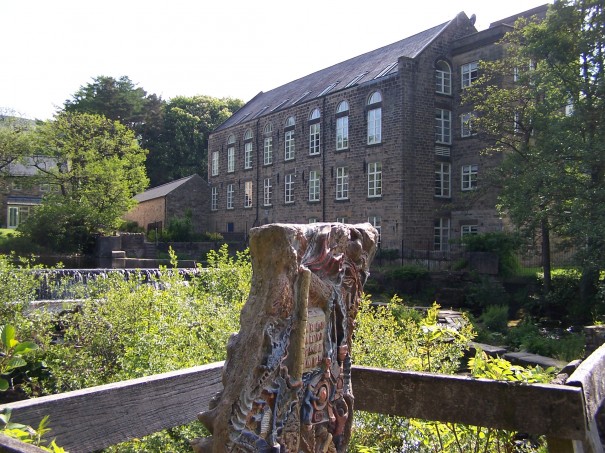
No wonder the footballer could not only afford to keep both a wife and a mistress, but could provide such luxuries for his mistress
as Poppy had seen on the topmost floor of the mill. Yet the footballer’s
mistress had not taken up residence in her new home. Poppy
found herself pondering more with each day that passed what woman would allow herself to be so used, and yet not take advantage of her lover’s gifts.
In the foreground of the picture to the right is one of the installations on the sculpture trail that was created to celebrate the millennium.
Here’s a very short description of how Poppy first sees The Footballer’s Mistress:
The footballer’s mistress had skin the colour of a freshly shelled conker. She wore smart trousers and a jacket similar to those of women living elsewhere in the mill, who went out to work in offices, not the gaudy fripperies of a harlot. Her hair was unnaturally straight, and surprisingly long—falling below her shoulders—and it was a golden colour, rather than the dark, dark brown that Poppy’s curls had been.
And finally, we end our tour with the view out over Shatton that I promised earlier:
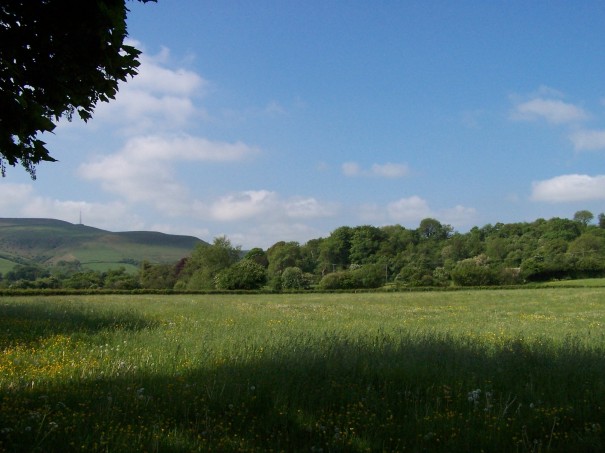
I hope you liked my little tour. Later in the summer I shall track down new views of Portchester Castle, and talk about its relationship to Hawks and Dragon.
* * *
Don’t have a copy of A Series of Ordinary Adventures yet? Get thee over to Reviews and Ramblings, where you can win a copy as part of the UK GLBTQ Meet eBook Giveaway!

Pingback: Pressing Matters: June 21, 2013, Edition | Candlemark & Gleam